Divine Denim: Business Strategy, Costing, and Budget Analysis
VerifiedAdded on 2022/09/16
|12
|1711
|14
Homework Assignment
AI Summary
This assignment analyzes Divine Denim, a company specializing in custom and ready-to-wear denim products. It begins with a Porter's Five Forces analysis to assess the competitive landscape for both the made-to-measure and ready-to-wear businesses, highlighting the strategic implications of each. The assignment then delves into cost allocation, presenting direct and step-down methods, alongside a reciprocal method solution. Process costing is examined using weighted average and FIFO methods. Finally, the assignment includes cash budgeting for the company, presenting a cash budget, schedule of cash collections, and cash paid for purchases and expenses, followed by an interpretation and revised cash budget to address the company's cash flow challenges. The analysis emphasizes the importance of budgeting for strategic planning and cost control.

Q1: Business Background
Porter's Five Forces and
Organisational Strategies
(PFFOS) Summary
How PFFOS affect the made
to measure business
How PFFOS affect the
RTW business
The porter’s five forces model
developed by Michael porter is a
strategic tool that analyzes the
attractiveness of the industry and
its likely profitability. It is one of
the most widely used strategic
management tool since its
inception in 1979. The model
suggests there are various forces in
the environment, which constantly
communicates, and affect the
industry and one should examine
them, analyze and recognize them
while formulating their business
strategies. These forces which he
identified includes keeping a close
eye on your rivals, assess the threat
that may arise due to substitution
available in the market, threat of
new entrants in the industry,
combat and minimize the
bargaining powers of customers
and suppliers in the value chain.
Porter further framed generic
strategies, which companies could
The measure business of Helen
Croker involves making
customized designer denim
jeans and jackets by taking
measurements of each client
individually and then custom
tailor the garments to fit the
client. She takes measurement
on her own for clients in town
and uses the online tool for
international clients where the
clients can take their
measurement themselves and
upload it in the online tool for
custom denims.
For this business, Helen is
using a Broad Differentiation
strategy where the
differentiated products
(customized denims) are made
available to large customer
base globally.
The porters 5 forces analysis
reveal the industry do not face
stiff competition as there are
not many manufacturers
The RTW or the Ready
to Wear collection is our
new launch that will be
made in Australia and
sold world wide at a
cheaper rate. The
generic strategy that
Helen is following for
this division of the
business is Cost
Leadership where low
cost standards products
will be made available
to a large group of
customers.
For the RTW business,
Porter’s 5 forces model
reveal that the
competition in this RTW
business is intense as
there are many players
offering standard RTW
products globally. The
customers enjoy huge
bargaining powers as
they are many and the
1
Porter's Five Forces and
Organisational Strategies
(PFFOS) Summary
How PFFOS affect the made
to measure business
How PFFOS affect the
RTW business
The porter’s five forces model
developed by Michael porter is a
strategic tool that analyzes the
attractiveness of the industry and
its likely profitability. It is one of
the most widely used strategic
management tool since its
inception in 1979. The model
suggests there are various forces in
the environment, which constantly
communicates, and affect the
industry and one should examine
them, analyze and recognize them
while formulating their business
strategies. These forces which he
identified includes keeping a close
eye on your rivals, assess the threat
that may arise due to substitution
available in the market, threat of
new entrants in the industry,
combat and minimize the
bargaining powers of customers
and suppliers in the value chain.
Porter further framed generic
strategies, which companies could
The measure business of Helen
Croker involves making
customized designer denim
jeans and jackets by taking
measurements of each client
individually and then custom
tailor the garments to fit the
client. She takes measurement
on her own for clients in town
and uses the online tool for
international clients where the
clients can take their
measurement themselves and
upload it in the online tool for
custom denims.
For this business, Helen is
using a Broad Differentiation
strategy where the
differentiated products
(customized denims) are made
available to large customer
base globally.
The porters 5 forces analysis
reveal the industry do not face
stiff competition as there are
not many manufacturers
The RTW or the Ready
to Wear collection is our
new launch that will be
made in Australia and
sold world wide at a
cheaper rate. The
generic strategy that
Helen is following for
this division of the
business is Cost
Leadership where low
cost standards products
will be made available
to a large group of
customers.
For the RTW business,
Porter’s 5 forces model
reveal that the
competition in this RTW
business is intense as
there are many players
offering standard RTW
products globally. The
customers enjoy huge
bargaining powers as
they are many and the
1
Paraphrase This Document
Need a fresh take? Get an instant paraphrase of this document with our AI Paraphraser
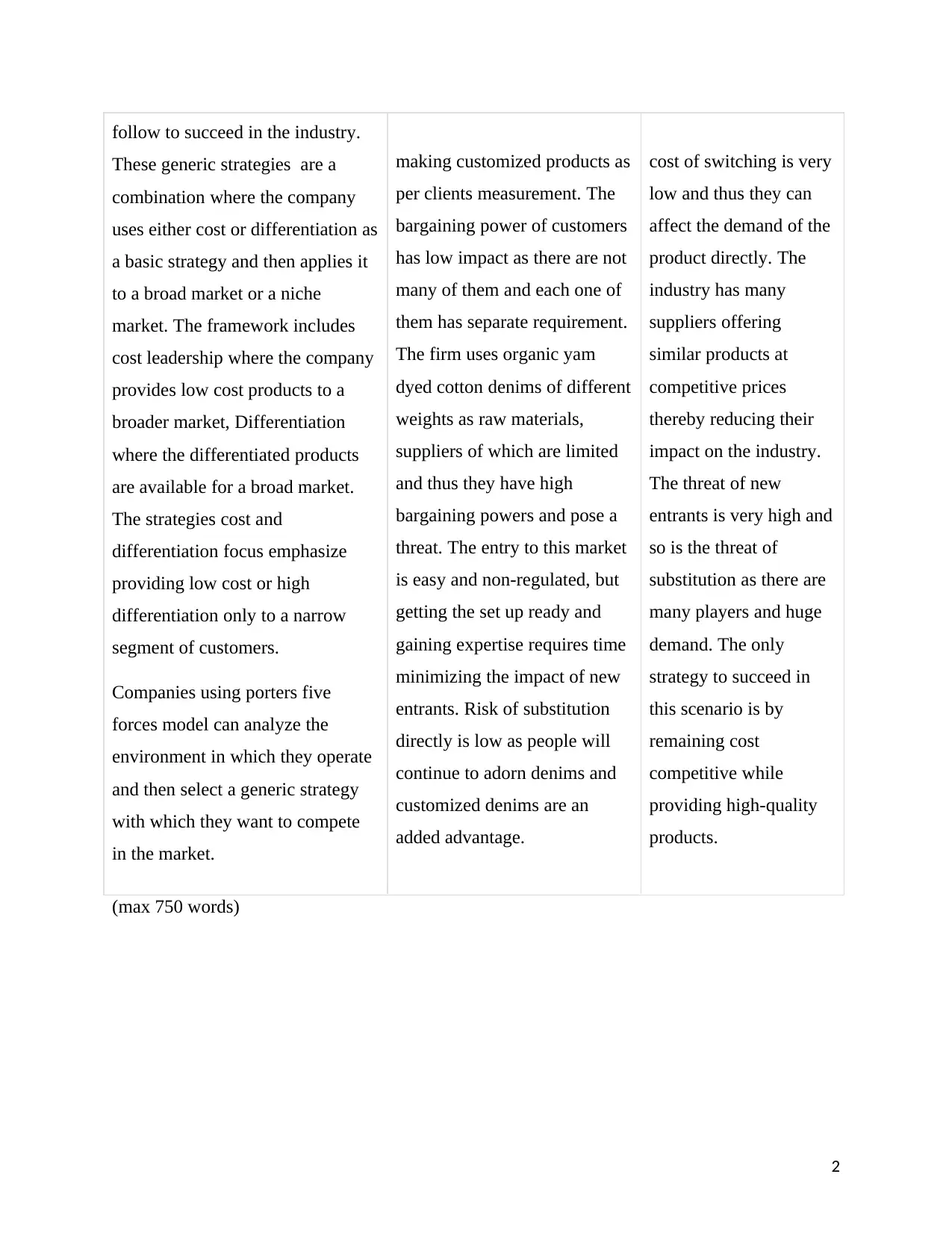
follow to succeed in the industry.
These generic strategies are a
combination where the company
uses either cost or differentiation as
a basic strategy and then applies it
to a broad market or a niche
market. The framework includes
cost leadership where the company
provides low cost products to a
broader market, Differentiation
where the differentiated products
are available for a broad market.
The strategies cost and
differentiation focus emphasize
providing low cost or high
differentiation only to a narrow
segment of customers.
Companies using porters five
forces model can analyze the
environment in which they operate
and then select a generic strategy
with which they want to compete
in the market.
making customized products as
per clients measurement. The
bargaining power of customers
has low impact as there are not
many of them and each one of
them has separate requirement.
The firm uses organic yam
dyed cotton denims of different
weights as raw materials,
suppliers of which are limited
and thus they have high
bargaining powers and pose a
threat. The entry to this market
is easy and non-regulated, but
getting the set up ready and
gaining expertise requires time
minimizing the impact of new
entrants. Risk of substitution
directly is low as people will
continue to adorn denims and
customized denims are an
added advantage.
cost of switching is very
low and thus they can
affect the demand of the
product directly. The
industry has many
suppliers offering
similar products at
competitive prices
thereby reducing their
impact on the industry.
The threat of new
entrants is very high and
so is the threat of
substitution as there are
many players and huge
demand. The only
strategy to succeed in
this scenario is by
remaining cost
competitive while
providing high-quality
products.
(max 750 words)
2
These generic strategies are a
combination where the company
uses either cost or differentiation as
a basic strategy and then applies it
to a broad market or a niche
market. The framework includes
cost leadership where the company
provides low cost products to a
broader market, Differentiation
where the differentiated products
are available for a broad market.
The strategies cost and
differentiation focus emphasize
providing low cost or high
differentiation only to a narrow
segment of customers.
Companies using porters five
forces model can analyze the
environment in which they operate
and then select a generic strategy
with which they want to compete
in the market.
making customized products as
per clients measurement. The
bargaining power of customers
has low impact as there are not
many of them and each one of
them has separate requirement.
The firm uses organic yam
dyed cotton denims of different
weights as raw materials,
suppliers of which are limited
and thus they have high
bargaining powers and pose a
threat. The entry to this market
is easy and non-regulated, but
getting the set up ready and
gaining expertise requires time
minimizing the impact of new
entrants. Risk of substitution
directly is low as people will
continue to adorn denims and
customized denims are an
added advantage.
cost of switching is very
low and thus they can
affect the demand of the
product directly. The
industry has many
suppliers offering
similar products at
competitive prices
thereby reducing their
impact on the industry.
The threat of new
entrants is very high and
so is the threat of
substitution as there are
many players and huge
demand. The only
strategy to succeed in
this scenario is by
remaining cost
competitive while
providing high-quality
products.
(max 750 words)
2
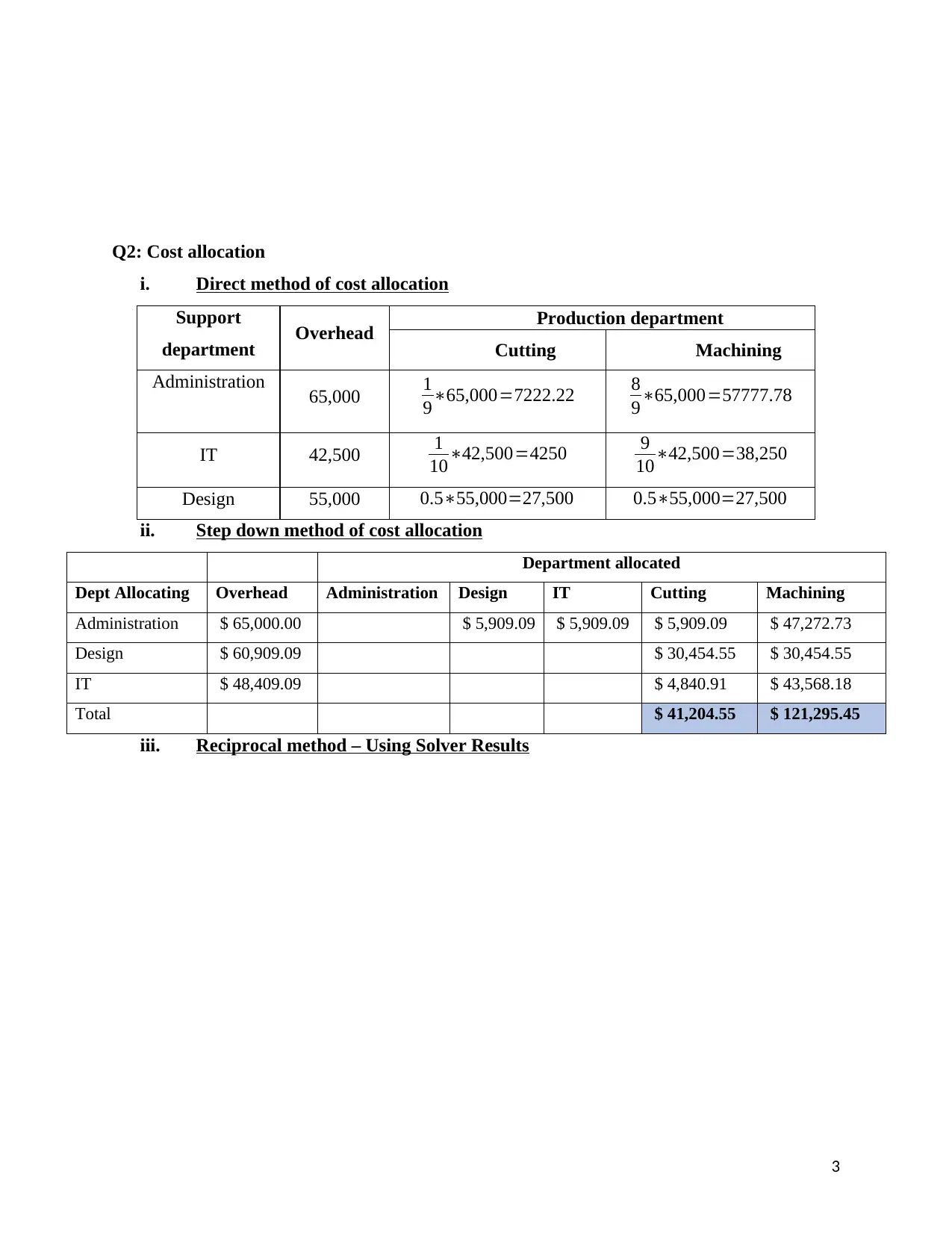
Q2: Cost allocation
i. Direct method of cost allocation
Support
department Overhead Production department
Cutting Machining
Administration 65,000 1
9∗65,000=7222.22 8
9∗65,000=57777.78
IT 42,500 1
10∗42,500=4250 9
10∗42,500=38,250
Design 55,000 0.5∗55,000=27,500 0.5∗55,000=27,500
ii. Step down method of cost allocation
Department allocated
Dept Allocating Overhead Administration Design IT Cutting Machining
Administration $ 65,000.00 $ 5,909.09 $ 5,909.09 $ 5,909.09 $ 47,272.73
Design $ 60,909.09 $ 30,454.55 $ 30,454.55
IT $ 48,409.09 $ 4,840.91 $ 43,568.18
Total $ 41,204.55 $ 121,295.45
iii. Reciprocal method – Using Solver Results
3
i. Direct method of cost allocation
Support
department Overhead Production department
Cutting Machining
Administration 65,000 1
9∗65,000=7222.22 8
9∗65,000=57777.78
IT 42,500 1
10∗42,500=4250 9
10∗42,500=38,250
Design 55,000 0.5∗55,000=27,500 0.5∗55,000=27,500
ii. Step down method of cost allocation
Department allocated
Dept Allocating Overhead Administration Design IT Cutting Machining
Administration $ 65,000.00 $ 5,909.09 $ 5,909.09 $ 5,909.09 $ 47,272.73
Design $ 60,909.09 $ 30,454.55 $ 30,454.55
IT $ 48,409.09 $ 4,840.91 $ 43,568.18
Total $ 41,204.55 $ 121,295.45
iii. Reciprocal method – Using Solver Results
3
⊘ This is a preview!⊘
Do you want full access?
Subscribe today to unlock all pages.

Trusted by 1+ million students worldwide

Formula view
4
4
Paraphrase This Document
Need a fresh take? Get an instant paraphrase of this document with our AI Paraphraser
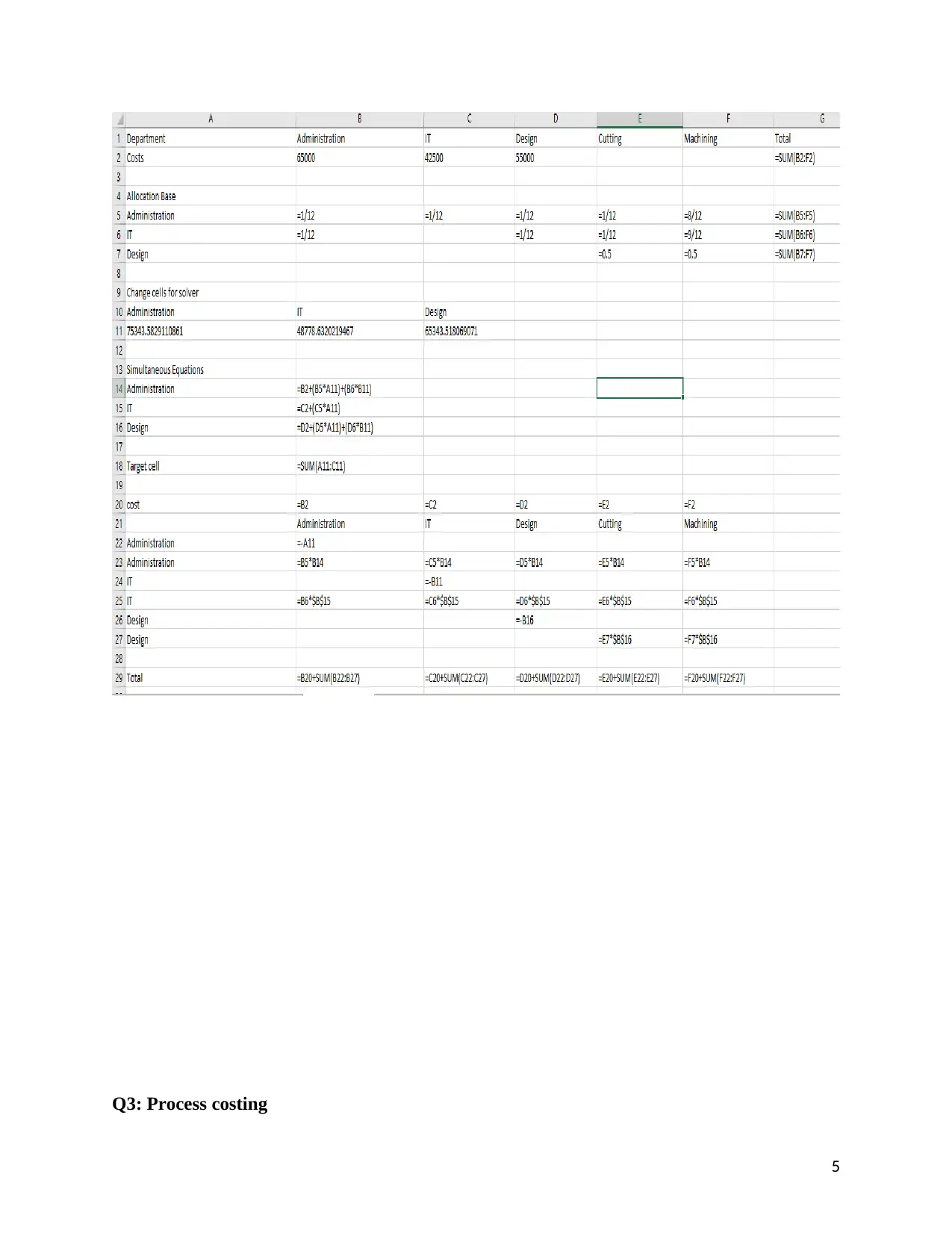
Q3: Process costing
5
5
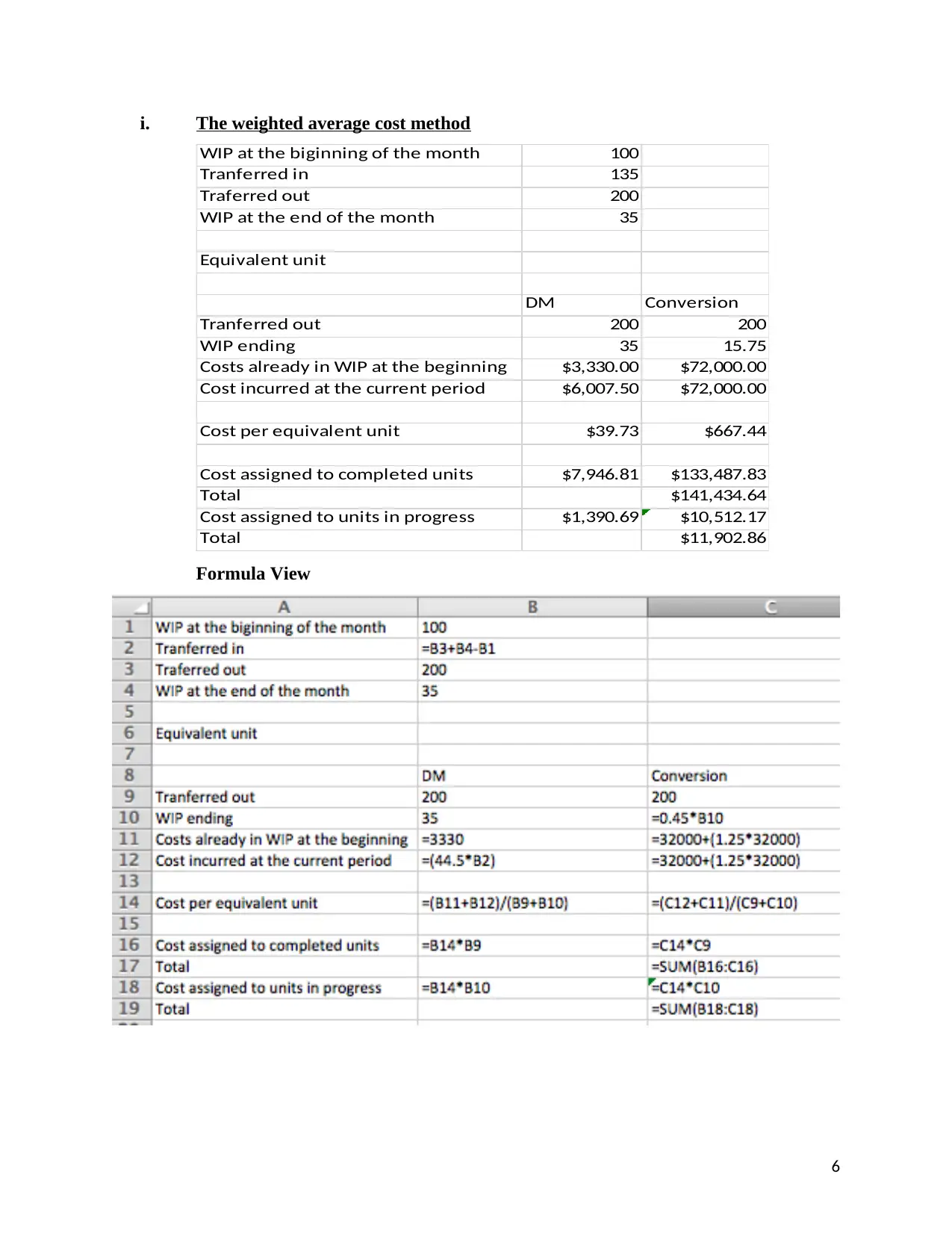
i. The weighted average cost method
WIP at the biginning of the month 100
Tranferred in 135
Traferred out 200
WIP at the end of the month 35
Equivalent unit
DM Conversion
Tranferred out 200 200
WIP ending 35 15.75
Costs already in WIP at the beginning $3,330.00 $72,000.00
Cost incurred at the current period $6,007.50 $72,000.00
Cost per equivalent unit $39.73 $667.44
Cost assigned to completed units $7,946.81 $133,487.83
Total $141,434.64
Cost assigned to units in progress $1,390.69 $10,512.17
Total $11,902.86
Formula View
6
WIP at the biginning of the month 100
Tranferred in 135
Traferred out 200
WIP at the end of the month 35
Equivalent unit
DM Conversion
Tranferred out 200 200
WIP ending 35 15.75
Costs already in WIP at the beginning $3,330.00 $72,000.00
Cost incurred at the current period $6,007.50 $72,000.00
Cost per equivalent unit $39.73 $667.44
Cost assigned to completed units $7,946.81 $133,487.83
Total $141,434.64
Cost assigned to units in progress $1,390.69 $10,512.17
Total $11,902.86
Formula View
6
⊘ This is a preview!⊘
Do you want full access?
Subscribe today to unlock all pages.

Trusted by 1+ million students worldwide

ii. FIFO method
WIP at the beginning of the month 100
Transferred in 200
Transferred out 275
WIP at the end of the month 25
Equivalent unit
DM Conversion
Transferred out 275 0
WIP ending 35 15.75
Costs already in WIP at the
beginning $3,330.00 $32,000.00
Cost incurred at the current period $8,900.00 $32,000.00
Cost per equivalent unit $39.45 $4,063.49
Cost assigned to completed units $10,849.19 $0.00
Total $10,849.19
Cost assigned to units in progress $1,380.81 $64,000.00
Total $65,380.81
Formula View
7
WIP at the beginning of the month 100
Transferred in 200
Transferred out 275
WIP at the end of the month 25
Equivalent unit
DM Conversion
Transferred out 275 0
WIP ending 35 15.75
Costs already in WIP at the
beginning $3,330.00 $32,000.00
Cost incurred at the current period $8,900.00 $32,000.00
Cost per equivalent unit $39.45 $4,063.49
Cost assigned to completed units $10,849.19 $0.00
Total $10,849.19
Cost assigned to units in progress $1,380.81 $64,000.00
Total $65,380.81
Formula View
7
Paraphrase This Document
Need a fresh take? Get an instant paraphrase of this document with our AI Paraphraser
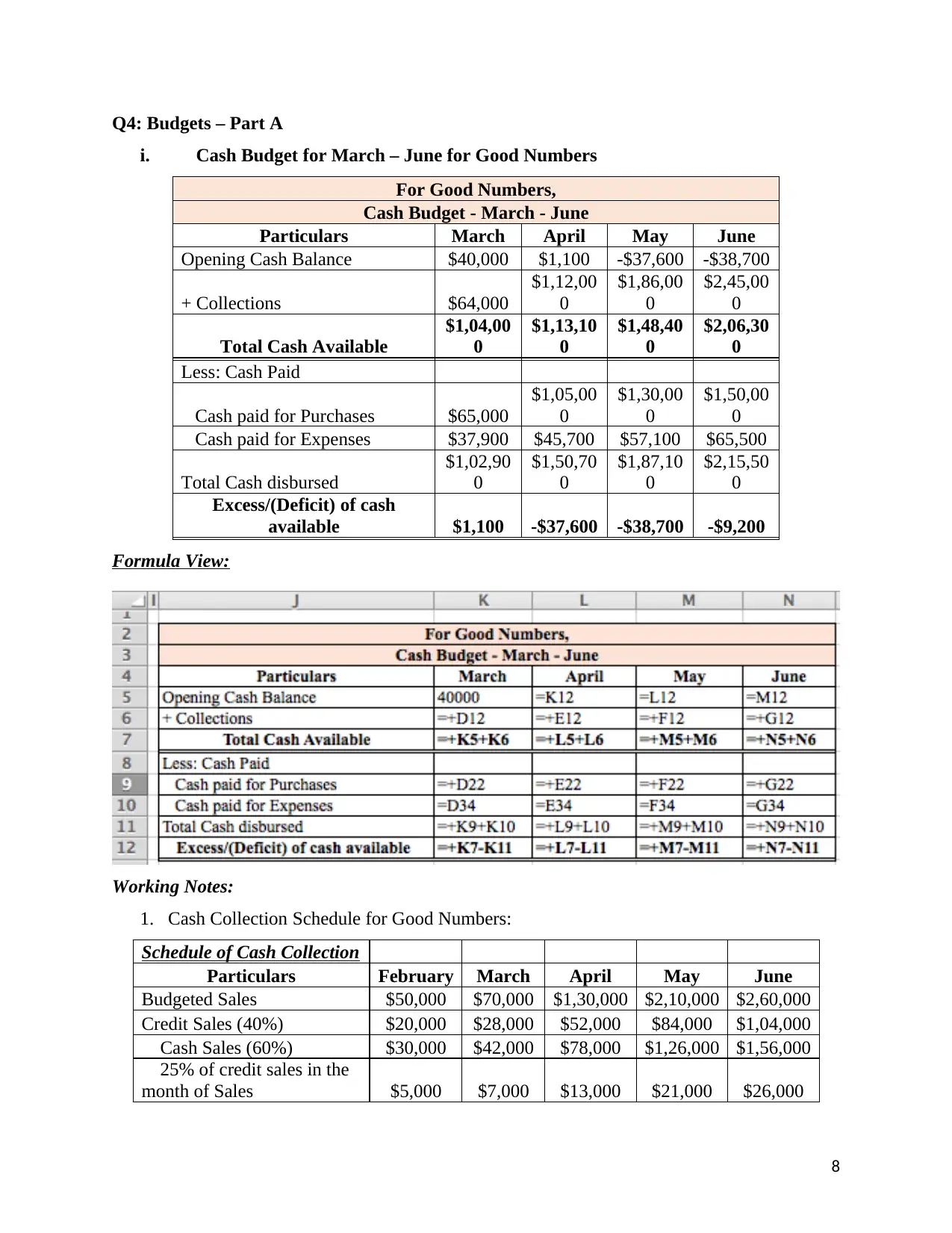
Q4: Budgets – Part A
i. Cash Budget for March – June for Good Numbers
For Good Numbers,
Cash Budget - March - June
Particulars March April May June
Opening Cash Balance $40,000 $1,100 -$37,600 -$38,700
+ Collections $64,000
$1,12,00
0
$1,86,00
0
$2,45,00
0
Total Cash Available
$1,04,00
0
$1,13,10
0
$1,48,40
0
$2,06,30
0
Less: Cash Paid
Cash paid for Purchases $65,000
$1,05,00
0
$1,30,00
0
$1,50,00
0
Cash paid for Expenses $37,900 $45,700 $57,100 $65,500
Total Cash disbursed
$1,02,90
0
$1,50,70
0
$1,87,10
0
$2,15,50
0
Excess/(Deficit) of cash
available $1,100 -$37,600 -$38,700 -$9,200
Formula View:
Working Notes:
1. Cash Collection Schedule for Good Numbers:
Schedule of Cash Collection
Particulars February March April May June
Budgeted Sales $50,000 $70,000 $1,30,000 $2,10,000 $2,60,000
Credit Sales (40%) $20,000 $28,000 $52,000 $84,000 $1,04,000
Cash Sales (60%) $30,000 $42,000 $78,000 $1,26,000 $1,56,000
25% of credit sales in the
month of Sales $5,000 $7,000 $13,000 $21,000 $26,000
8
i. Cash Budget for March – June for Good Numbers
For Good Numbers,
Cash Budget - March - June
Particulars March April May June
Opening Cash Balance $40,000 $1,100 -$37,600 -$38,700
+ Collections $64,000
$1,12,00
0
$1,86,00
0
$2,45,00
0
Total Cash Available
$1,04,00
0
$1,13,10
0
$1,48,40
0
$2,06,30
0
Less: Cash Paid
Cash paid for Purchases $65,000
$1,05,00
0
$1,30,00
0
$1,50,00
0
Cash paid for Expenses $37,900 $45,700 $57,100 $65,500
Total Cash disbursed
$1,02,90
0
$1,50,70
0
$1,87,10
0
$2,15,50
0
Excess/(Deficit) of cash
available $1,100 -$37,600 -$38,700 -$9,200
Formula View:
Working Notes:
1. Cash Collection Schedule for Good Numbers:
Schedule of Cash Collection
Particulars February March April May June
Budgeted Sales $50,000 $70,000 $1,30,000 $2,10,000 $2,60,000
Credit Sales (40%) $20,000 $28,000 $52,000 $84,000 $1,04,000
Cash Sales (60%) $30,000 $42,000 $78,000 $1,26,000 $1,56,000
25% of credit sales in the
month of Sales $5,000 $7,000 $13,000 $21,000 $26,000
8
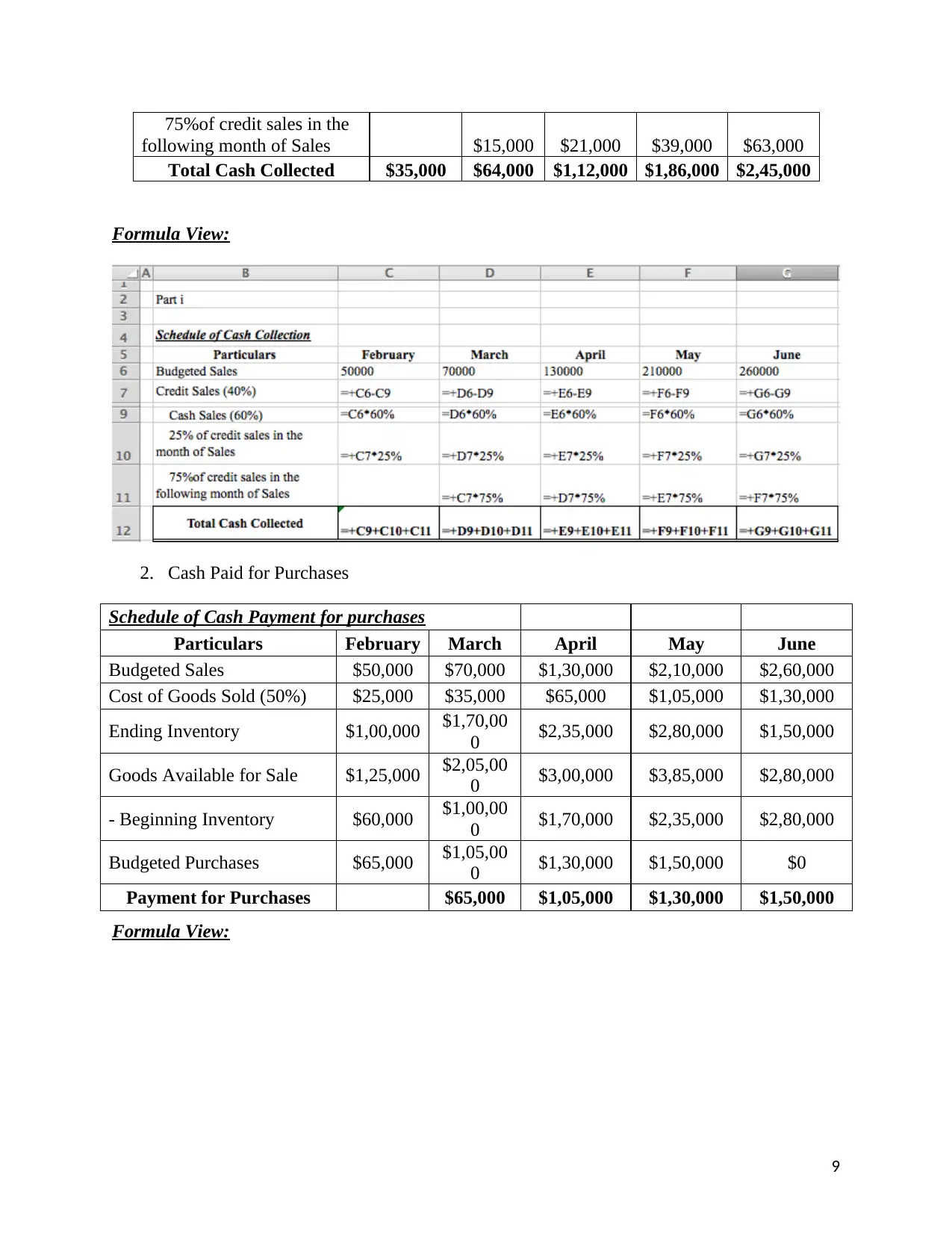
75%of credit sales in the
following month of Sales $15,000 $21,000 $39,000 $63,000
Total Cash Collected $35,000 $64,000 $1,12,000 $1,86,000 $2,45,000
Formula View:
2. Cash Paid for Purchases
Schedule of Cash Payment for purchases
Particulars February March April May June
Budgeted Sales $50,000 $70,000 $1,30,000 $2,10,000 $2,60,000
Cost of Goods Sold (50%) $25,000 $35,000 $65,000 $1,05,000 $1,30,000
Ending Inventory $1,00,000 $1,70,00
0 $2,35,000 $2,80,000 $1,50,000
Goods Available for Sale $1,25,000 $2,05,00
0 $3,00,000 $3,85,000 $2,80,000
- Beginning Inventory $60,000 $1,00,00
0 $1,70,000 $2,35,000 $2,80,000
Budgeted Purchases $65,000 $1,05,00
0 $1,30,000 $1,50,000 $0
Payment for Purchases $65,000 $1,05,000 $1,30,000 $1,50,000
Formula View:
9
following month of Sales $15,000 $21,000 $39,000 $63,000
Total Cash Collected $35,000 $64,000 $1,12,000 $1,86,000 $2,45,000
Formula View:
2. Cash Paid for Purchases
Schedule of Cash Payment for purchases
Particulars February March April May June
Budgeted Sales $50,000 $70,000 $1,30,000 $2,10,000 $2,60,000
Cost of Goods Sold (50%) $25,000 $35,000 $65,000 $1,05,000 $1,30,000
Ending Inventory $1,00,000 $1,70,00
0 $2,35,000 $2,80,000 $1,50,000
Goods Available for Sale $1,25,000 $2,05,00
0 $3,00,000 $3,85,000 $2,80,000
- Beginning Inventory $60,000 $1,00,00
0 $1,70,000 $2,35,000 $2,80,000
Budgeted Purchases $65,000 $1,05,00
0 $1,30,000 $1,50,000 $0
Payment for Purchases $65,000 $1,05,000 $1,30,000 $1,50,000
Formula View:
9
⊘ This is a preview!⊘
Do you want full access?
Subscribe today to unlock all pages.

Trusted by 1+ million students worldwide
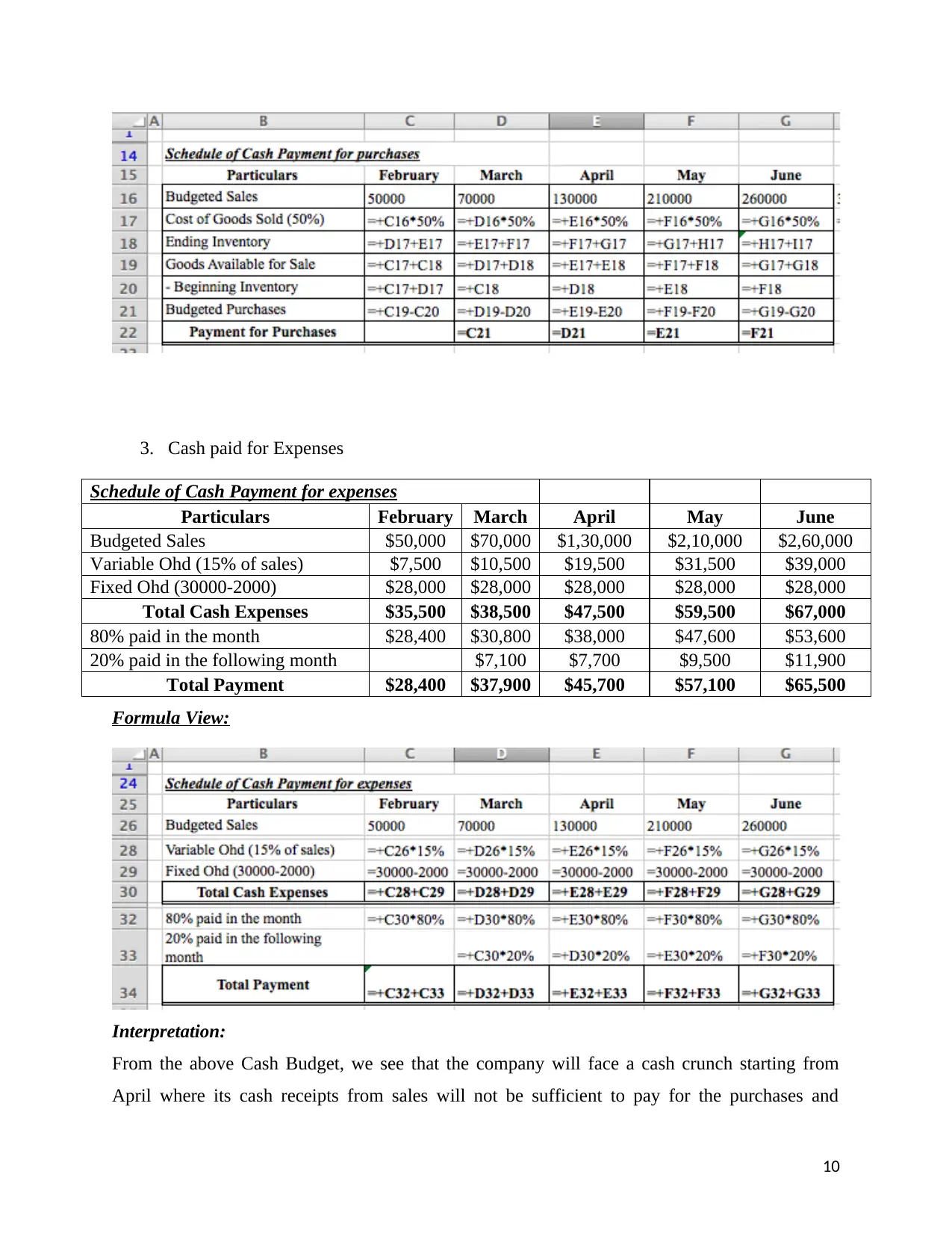
3. Cash paid for Expenses
Schedule of Cash Payment for expenses
Particulars February March April May June
Budgeted Sales $50,000 $70,000 $1,30,000 $2,10,000 $2,60,000
Variable Ohd (15% of sales) $7,500 $10,500 $19,500 $31,500 $39,000
Fixed Ohd (30000-2000) $28,000 $28,000 $28,000 $28,000 $28,000
Total Cash Expenses $35,500 $38,500 $47,500 $59,500 $67,000
80% paid in the month $28,400 $30,800 $38,000 $47,600 $53,600
20% paid in the following month $7,100 $7,700 $9,500 $11,900
Total Payment $28,400 $37,900 $45,700 $57,100 $65,500
Formula View:
Interpretation:
From the above Cash Budget, we see that the company will face a cash crunch starting from
April where its cash receipts from sales will not be sufficient to pay for the purchases and
10
Schedule of Cash Payment for expenses
Particulars February March April May June
Budgeted Sales $50,000 $70,000 $1,30,000 $2,10,000 $2,60,000
Variable Ohd (15% of sales) $7,500 $10,500 $19,500 $31,500 $39,000
Fixed Ohd (30000-2000) $28,000 $28,000 $28,000 $28,000 $28,000
Total Cash Expenses $35,500 $38,500 $47,500 $59,500 $67,000
80% paid in the month $28,400 $30,800 $38,000 $47,600 $53,600
20% paid in the following month $7,100 $7,700 $9,500 $11,900
Total Payment $28,400 $37,900 $45,700 $57,100 $65,500
Formula View:
Interpretation:
From the above Cash Budget, we see that the company will face a cash crunch starting from
April where its cash receipts from sales will not be sufficient to pay for the purchases and
10
Paraphrase This Document
Need a fresh take? Get an instant paraphrase of this document with our AI Paraphraser
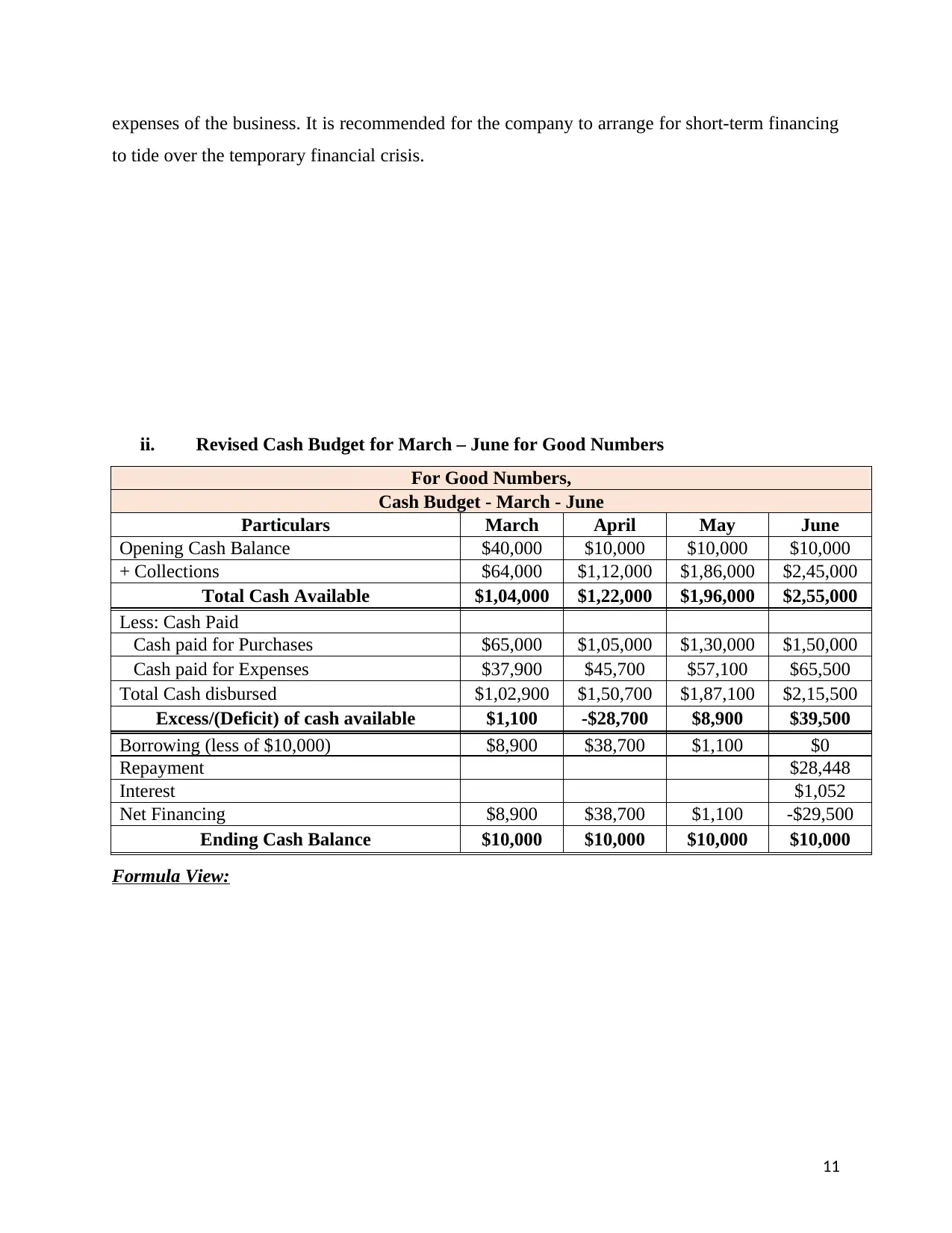
expenses of the business. It is recommended for the company to arrange for short-term financing
to tide over the temporary financial crisis.
ii. Revised Cash Budget for March – June for Good Numbers
For Good Numbers,
Cash Budget - March - June
Particulars March April May June
Opening Cash Balance $40,000 $10,000 $10,000 $10,000
+ Collections $64,000 $1,12,000 $1,86,000 $2,45,000
Total Cash Available $1,04,000 $1,22,000 $1,96,000 $2,55,000
Less: Cash Paid
Cash paid for Purchases $65,000 $1,05,000 $1,30,000 $1,50,000
Cash paid for Expenses $37,900 $45,700 $57,100 $65,500
Total Cash disbursed $1,02,900 $1,50,700 $1,87,100 $2,15,500
Excess/(Deficit) of cash available $1,100 -$28,700 $8,900 $39,500
Borrowing (less of $10,000) $8,900 $38,700 $1,100 $0
Repayment $28,448
Interest $1,052
Net Financing $8,900 $38,700 $1,100 -$29,500
Ending Cash Balance $10,000 $10,000 $10,000 $10,000
Formula View:
11
to tide over the temporary financial crisis.
ii. Revised Cash Budget for March – June for Good Numbers
For Good Numbers,
Cash Budget - March - June
Particulars March April May June
Opening Cash Balance $40,000 $10,000 $10,000 $10,000
+ Collections $64,000 $1,12,000 $1,86,000 $2,45,000
Total Cash Available $1,04,000 $1,22,000 $1,96,000 $2,55,000
Less: Cash Paid
Cash paid for Purchases $65,000 $1,05,000 $1,30,000 $1,50,000
Cash paid for Expenses $37,900 $45,700 $57,100 $65,500
Total Cash disbursed $1,02,900 $1,50,700 $1,87,100 $2,15,500
Excess/(Deficit) of cash available $1,100 -$28,700 $8,900 $39,500
Borrowing (less of $10,000) $8,900 $38,700 $1,100 $0
Repayment $28,448
Interest $1,052
Net Financing $8,900 $38,700 $1,100 -$29,500
Ending Cash Balance $10,000 $10,000 $10,000 $10,000
Formula View:
11
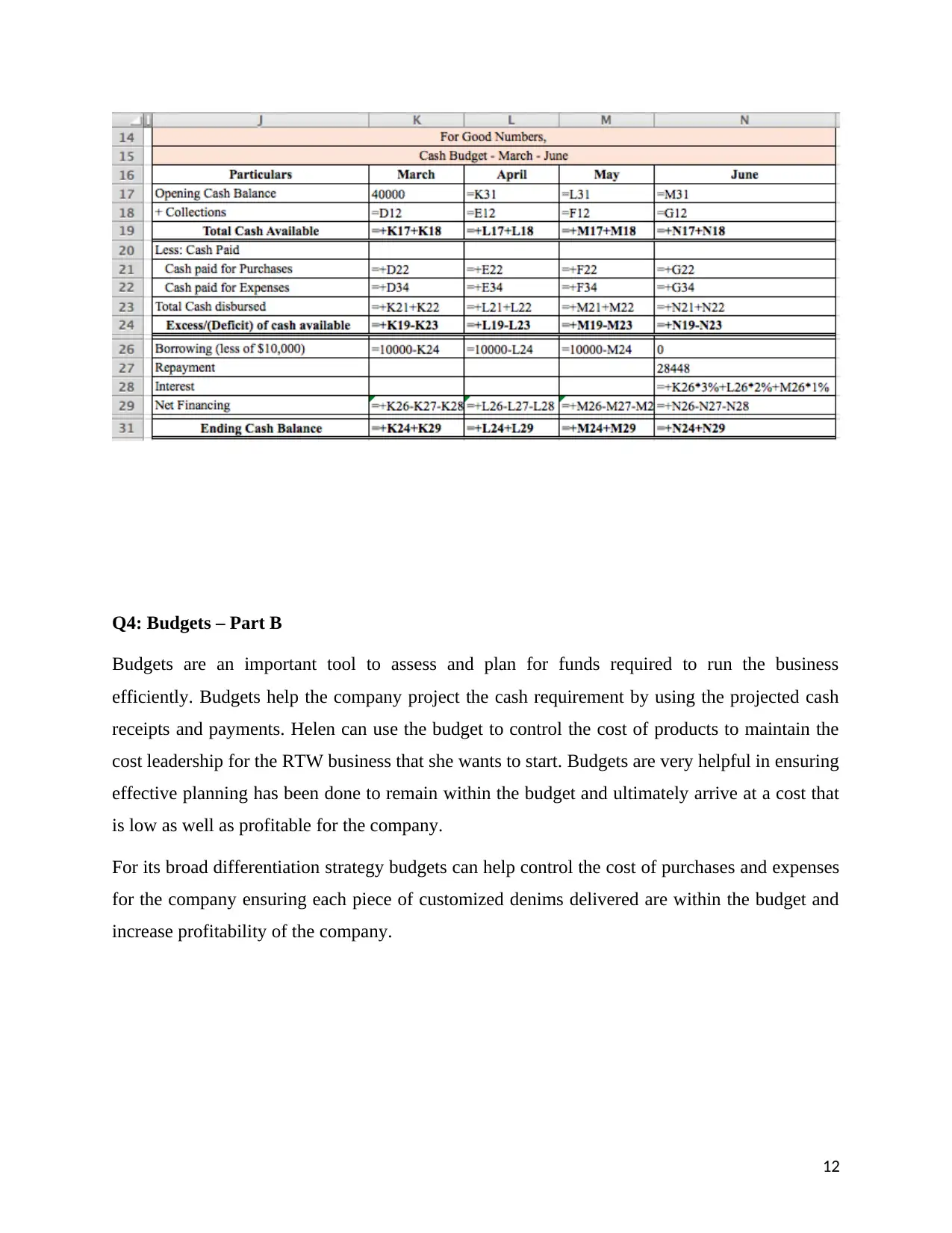
Q4: Budgets – Part B
Budgets are an important tool to assess and plan for funds required to run the business
efficiently. Budgets help the company project the cash requirement by using the projected cash
receipts and payments. Helen can use the budget to control the cost of products to maintain the
cost leadership for the RTW business that she wants to start. Budgets are very helpful in ensuring
effective planning has been done to remain within the budget and ultimately arrive at a cost that
is low as well as profitable for the company.
For its broad differentiation strategy budgets can help control the cost of purchases and expenses
for the company ensuring each piece of customized denims delivered are within the budget and
increase profitability of the company.
12
Budgets are an important tool to assess and plan for funds required to run the business
efficiently. Budgets help the company project the cash requirement by using the projected cash
receipts and payments. Helen can use the budget to control the cost of products to maintain the
cost leadership for the RTW business that she wants to start. Budgets are very helpful in ensuring
effective planning has been done to remain within the budget and ultimately arrive at a cost that
is low as well as profitable for the company.
For its broad differentiation strategy budgets can help control the cost of purchases and expenses
for the company ensuring each piece of customized denims delivered are within the budget and
increase profitability of the company.
12
⊘ This is a preview!⊘
Do you want full access?
Subscribe today to unlock all pages.

Trusted by 1+ million students worldwide
1 out of 12
Related Documents
Your All-in-One AI-Powered Toolkit for Academic Success.
+13062052269
info@desklib.com
Available 24*7 on WhatsApp / Email
![[object Object]](/_next/static/media/star-bottom.7253800d.svg)
Unlock your academic potential
Copyright © 2020–2025 A2Z Services. All Rights Reserved. Developed and managed by ZUCOL.





